Solar eclipse of June 30, 1954
| Solar eclipse of June 30, 1954 | |
|---|---|
| Type of eclipse | |
| Nature | Total |
| Gamma | 0.6135 |
| Magnitude | 1.0357 |
| Maximum eclipse | |
| Duration | 155 s (2 min 35 s) |
| Coordinates | 60°30′N 4°12′E / 60.5°N 4.2°E |
| Max. width of band | 153 km (95 mi) |
| Times (UTC) | |
| Greatest eclipse | 12:32:38 |
| References | |
| Saros | 126 (44 of 72) |
| Catalog # (SE5000) | 9408 |
A total solar eclipse occurred at the Moon's descending node of the orbit on Wednesday, June 30, 1954. A solar eclipse occurs when the Moon passes between Earth and the Sun, thereby totally or partly obscuring the image of the Sun for a viewer on Earth. A total solar eclipse occurs when the Moon's apparent diameter is larger than the Sun's, blocking all direct sunlight, turning day into darkness. Totality occurs in a narrow path across Earth's surface, with the partial solar eclipse visible over a surrounding region thousands of kilometres wide. Occurring only 3.1 days after perigee (on June 27, 1954), the Moon's apparent diameter was larger. Totality lasted 2 minutes and 34.93 seconds, but at sunrise 1 minute and 8.6 seconds and at sunset 1 minute and 5.3 seconds. The moon's apparent diameter was larger, 1930.2 arc-seconds.
Visibility
Totality began at sunrise over the United States over Nebraska, South Dakota, Minnesota, and Wisconsin, and crossed into Canada, across southern Greenland, Iceland and Faroe Islands, then into Europe, across Norway, Sweden, and eastern Europe.[1] It ended before sunset over Iran, Afghanistan, Pakistan, and ending in northwestern India. The southwestern part of Vilnius, northeastern part of Kyiv, and southwestern part of Baku were covered by the path of totality.
The northeastern part of Mount Elbrus, the highest mountain in Europe, also lay in the path of totality.
The eclipse was mostly seen on June 30, 1954, except for northeastern Soviet Union, where a partial eclipse started on June 30, passing midnight and ended on July 1 due to the midnight sun.
Observation
Within the United Kingdom, the path of totality only covered Shetland Islands in northern Scotland. However, the area was mostly clouded out during the eclipse, and there was even light rain in some places, so observation was not successful. About 400 scientists from around the world traveled to Sweden to observe the total eclipse.[2] The Astronomy Department of Kiev State University, Soviet Union made observation in Kyiv and took ideal images of solar corona. The Sternberg Astronomical Institute made observation in Nevinnomyssk, Stavropol Krai.[3]
In Wakefield, Massachusetts, U.S., the eclipse was blocked by heavy cloud cover from 6 to 8 a.m. local time, The Wakefield Daily Item reported.[4]
Related eclipses
Solar eclipses of 1953–1956
This eclipse is a member of a semester series. An eclipse in a semester series of solar eclipses repeats approximately every 177 days and 4 hours (a semester) at alternating nodes of the Moon's orbit.[5]
The partial solar eclipses on February 14, 1953 and August 9, 1953 occur in the previous lunar year eclipse set.
| Solar eclipse series sets from 1953 to 1956 | ||||||
|---|---|---|---|---|---|---|
| Descending node | Ascending node | |||||
| Saros | Map | Gamma | Saros | Map | Gamma | |
| 116 | July 11, 1953 Partial |
1.4388 | 121 | January 5, 1954 Annular |
−0.9296 | |
| 126 | June 30, 1954 Total |
0.6135 | 131 | December 25, 1954 Annular |
−0.2576 | |
| 136 | June 20, 1955 Total |
−0.1528 | 141 | December 14, 1955 Annular |
0.4266 | |
| 146 | June 8, 1956 Total |
−0.8934 | 151 | December 2, 1956 Partial |
1.0923 | |
Saros 126
This eclipse is a part of Saros series 126, repeating every 18 years, 11 days, and containing 72 events. The series started with a partial solar eclipse on March 10, 1179. It contains annular eclipses from June 4, 1323 through April 4, 1810; hybrid eclipses from April 14, 1828 through May 6, 1864; and total eclipses from May 17, 1882 through August 23, 2044. The series ends at member 72 as a partial eclipse on May 3, 2459. Its eclipses are tabulated in three columns; every third eclipse in the same column is one exeligmos apart, so they all cast shadows over approximately the same parts of the Earth.
The longest duration of annularity was produced by member 11 at 6 minutes, 30 seconds on June 26, 1359, and the longest duration of totality was produced by member 45 at 2 minutes, 36 seconds on July 10, 1972. All eclipses in this series occur at the Moon’s descending node of orbit.[6]
| Series members 36–57 occur between 1801 and 2200: | ||
|---|---|---|
| 36 | 37 | 38 |
 April 4, 1810 |
 April 14, 1828 |
 April 25, 1846 |
| 39 | 40 | 41 |
 May 6, 1864 |
 May 17, 1882 |
 May 28, 1900 |
| 42 | 43 | 44 |
 June 8, 1918 |
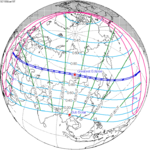 June 19, 1936 |
 June 30, 1954 |
| 45 | 46 | 47 |
 July 10, 1972 |
 July 22, 1990 |
 August 1, 2008 |
| 48 | 49 | 50 |
 August 12, 2026 |
 August 23, 2044 |
 September 3, 2062 |
| 51 | 52 | 53 |
 September 13, 2080 |
 September 25, 2098 |
 October 6, 2116 |
| 54 | 55 | 56 |
 October 17, 2134 |
 October 28, 2152 |
 November 8, 2170 |
| 57 | ||
 November 18, 2188 | ||
Metonic series
The metonic series repeats eclipses every 19 years (6939.69 days), lasting about 5 cycles. Eclipses occur in nearly the same calendar date. In addition, the octon subseries repeats 1/5 of that or every 3.8 years (1387.94 days). All eclipses in this table occur at the Moon's descending node.
| 22 eclipse events between September 12, 1931 and July 1, 2011. | ||||
|---|---|---|---|---|
| September 11-12 | June 30-July 1 | April 17-19 | February 4-5 | November 22-23 |
| 114 | 116 | 118 | 120 | 122 |
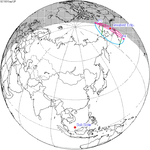 September 12, 1931 |
 June 30, 1935 |
 April 19, 1939 |
 February 4, 1943 |
 November 23, 1946 |
| 124 | 126 | 128 | 130 | 132 |
 September 12, 1950 |
 June 30, 1954 |
 April 19, 1958 |
 February 5, 1962 |
 November 23, 1965 |
| 134 | 136 | 138 | 140 | 142 |
 September 11, 1969 |
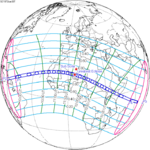 June 30, 1973 |
 April 18, 1977 |
 February 4, 1981 |
 November 22, 1984 |
| 144 | 146 | 148 | 150 | 152 |
 September 11, 1988 |
 June 30, 1992 |
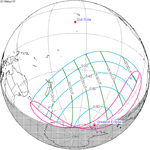 April 17, 1996 |
 February 5, 2000 |
 November 23, 2003 |
| 154 | 156 | |||
 September 11, 2007 |
 July 1, 2011 | |||
Inex series
This eclipse is a part of the long period inex cycle, repeating at alternating nodes, every 358 synodic months (≈ 10,571.95 days, or 29 years minus 20 days). Their appearance and longitude are irregular due to a lack of synchronization with the anomalistic month (period of perigee). However, groupings of 3 inex cycles (≈ 87 years minus 2 months) comes close (≈ 1,151.02 anomalistic months), so eclipses are similar in these groupings.
| Inex series members between 1901 and 2100: | ||
|---|---|---|
 July 20, 1925 (Saros 125) |
 June 30, 1954 (Saros 126) |
 June 11, 1983 (Saros 127) |
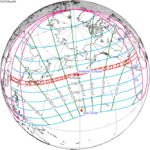 May 20, 2012 (Saros 128) |
 April 30, 2041 (Saros 129) |
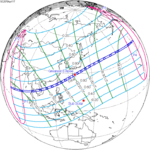 April 11, 2070 (Saros 130) |
 March 21, 2099 (Saros 131) |
||
See also
- List of solar eclipses visible from Russia
- List of solar eclipses visible from the United Kingdom
- Allais effect
Notes
- ^ Geneslay E., Meeus J., Schock P., Hujer, K. : « L’éclipse totale de Soleil du 30 juin 1954 », l'Astronomie, vol. 68, p. 422
- ^ "1954: Three continents see eclipse of sun". On This Day. BBC News. 30 June 1954. Archived from the original on 17 August 2020.
- ^ "КОРОНА ЭПОХИ МИНИМУМА СОЛНЕЧНОЙ АКТИВНОСТИ" (in Russian). IZMIRAN. Archived from the original on 21 October 2016.
- ^ Henshaw, Kristen (June 27, 2024). "Looking Backward: June 30, 1954". The Wakefield Daily Item. "Those who were looking forward to viewing the eclipse of the sun this morning were mightily disappointed. Between 6 and 8 am, the eclipse was hidden by stubborn heavy clouds that refused to move on."
- ^ van Gent, R.H. "Solar- and Lunar-Eclipse Predictions from Antiquity to the Present". A Catalogue of Eclipse Cycles. Utrecht University. Retrieved 6 October 2018.
- ^ "NASA - Catalog of Solar Eclipses of Saros 126". eclipse.gsfc.nasa.gov.
References
- Earth visibility chart and eclipse statistics Eclipse Predictions by Fred Espenak, NASA/GSFC
- Photo from Russia
- Solar eclipse of June 30, 1954 in Russia Archived August 9, 2009, at the Wayback Machine
- Photo of Solar eclipse
- BBC: 1954: Three continents see eclipse of sun (Article and video)
- http://retrofutureground.tumblr.com/post/99724896027/bill-seaman-story-of-eclipse-in-one-picture





